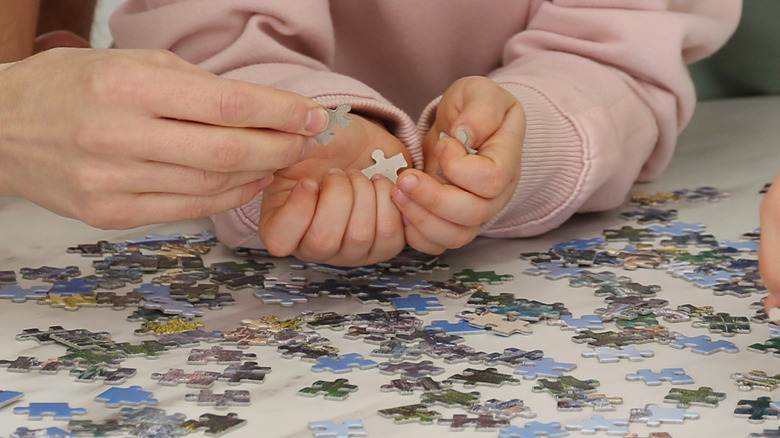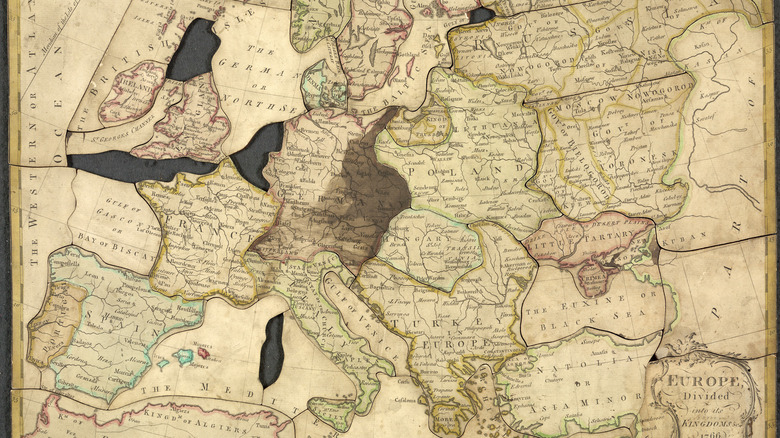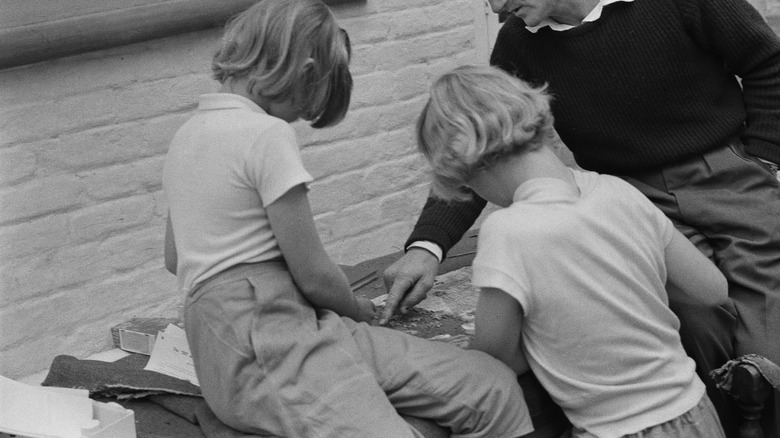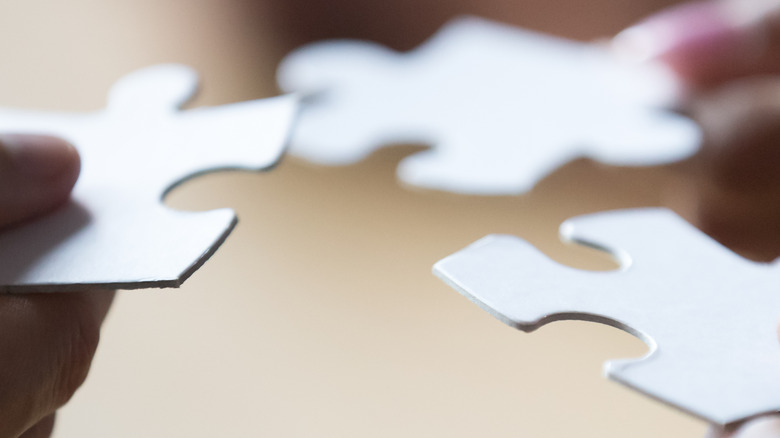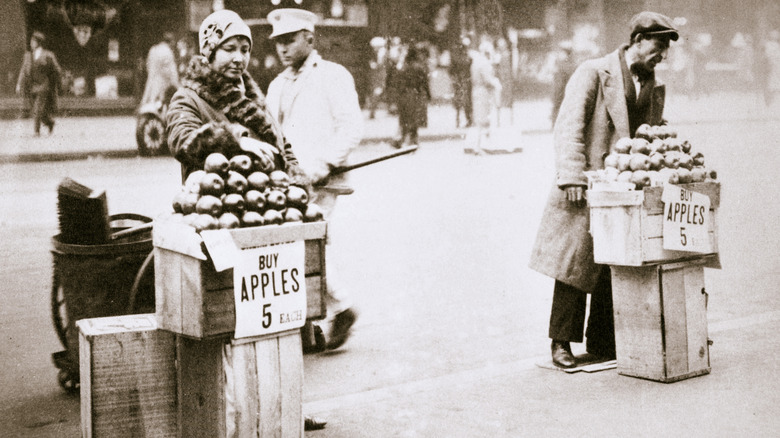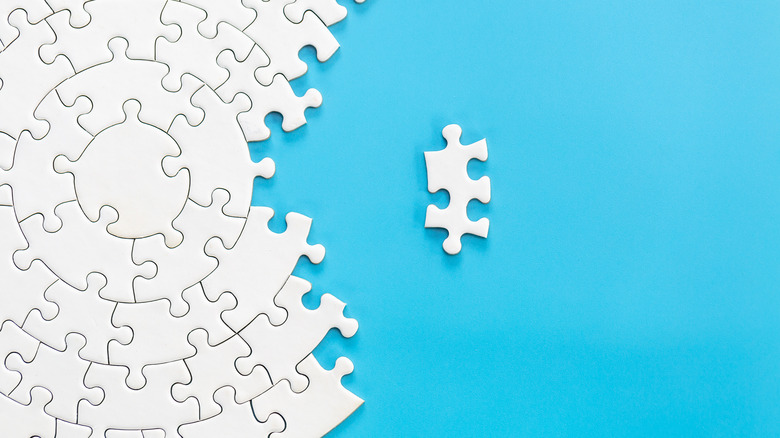The History Of Jigsaw Puzzles, Assembled
Across the world, tens of millions of people wind down and relax by assembling jigsaw puzzles. There's something indescribably soothing about sorting hundreds of strangely-cut pieces of cardboard into piles based on color, and then assembling them to make a coherent, final work of art. What's more, assembling jigsaw puzzles is an extremely inexpensive hobby. Your favorite retailer's toy section is filled with boxes and boxes of them, none costing more than a few dollars. And of course, at resale shops or rummage sales you can find them for a few coins (although you risk having box that contains only 498 of the promised 500 pieces).
The hobby has come a long way from its origins in teaching European geography to genteel English schoolchildren. Further, advances in industry and technology have meant that the price of a puzzle is borderline trivial, whereas even 100 years ago they were playthings of the extraordinarily wealthy.
A tool for teaching geography
The first jigsaw puzzle (pictured above) was created by English cartographer and engraver John Spilsbury, according to Wentworth Puzzles. The puzzle was a map of Europe, and the pieces were key parts of European geography: a vaguely Spain-shaped piece here, a vaguely Italy-shaped piece there, and so on. Spilsbury intended the device to teach European geography to children — at least, to children whose parents could afford them. This was well before mass production, and so each puzzle was hand-printed onto wood (cardboard wouldn't be invented for another century) and hand-cut. Only the very wealthy could afford them.
Spilsbury's puzzles bore little resemblance to what a modern dissectologist (that's what you call a jigsaw puzzle enthusiast, according to Puzzle Hour) works on. Perhaps the major difference between a Spilsbury puzzle and a modern one is the fact that the pieces in Spilsbury's puzzles didn't interlock the way modern ones do. Interlocking pieces wouldn't become a thing for another century.
Meanwhile, Spilsbury's puzzles, as a geography-teaching tool, soon expanded beyond Europe and would later include maps of the U.S., England and Wales, Africa, and so on, according to My Modern Met.
The early 1900s puzzle craze
The turn of the 20th century saw a jigsaw puzzle craze in the United States, according to Puzzle Warehouse. By this time, several things had changed in the industry since its early days in England. For one thing, the Industrial Revolution had come, meaning that mass production of puzzles was possible. For another, puzzle topics had moved from teaching tools and from their focus on being used by children to depictions of things adults would enjoy: nature scenes, magnificent European castles, and the like. There still were puzzles intended for children as well, such as depictions of animals or of fairy-tale scenes.
There remained several differences between those puzzles and today's. For one thing, the pieces didn't interlock, so a strong breeze could undo a day's work. For another, the boxes didn't depict the final image: the dissectologists figured it out as they went along. Though advances in industry and technology had driven the price down, they were still prohibitively expensive. In 1908, a 500-piece puzzle could cost $5, or roughly 10% of the monthly income of the average American worker.
Interlocking pieces changed everything
In the next couple of decades, some major innovations would change jigsaw puzzles forever. Advances in cutting technology enabled manufacturers to pump out puzzles without having to painstakingly hand-saw each individual piece. According to My Modern Met, die cutting — the use of a machine to mass-produce shapes — became a thing around this time, drastically reducing the time it took to make a puzzle and driving down cost. Also at about this time, manufacturers moved from making puzzles out of planks of wood to making them on particle board and, later, on cardboard. Collectively, innovation drove the price down to the point that the average American could afford jigsaw puzzles.
Another major change that took place at this time was the development of interlocking pieces. Toy manufacturer Parker Brothers was the first to come up with the new process, according to CBS News, which was itself aided in technological innovations in the saws that cut the pieces. Today, few modern jigsaw puzzles don't feature the knobs and holes and loops and sockets (that's what they're called in the industry, according to Puzzling Cut) that hold the pieces together.
The jigsaw puzzle craze of the Great Depression
The timing couldn't have been better for the jigsaw puzzle industry: Right about the time innovations in industry drove down the cost of jigsaw puzzles, the Great Depression struck, putting millions of Americans out of work. Now unemployed and needing something to do, bored Americans turned to jigsaw puzzles. A second jigsaw puzzle craze took place during this time, and as puzzle historian Anne Williams told CBS News, Americans couldn't get enough of them. Every week, "30 million households in the United States were absorbing 10 million jigsaw puzzles," she said. Those who couldn't afford to buy them rented them for a few cents, or even borrowed them from libraries the same way they borrowed books, according to Puzzle Warehouse.
Additionally, the Great Depression brought another form of jigsaw puzzle: the homebrew. With minimal investment, an unemployed architect or builder could purchase a saw capable of cutting puzzle pieces. Several unemployed tradesmen in these fields made an income producing and selling (or renting) jigsaw puzzles during this time.
The future of jigsaw puzzles: The sky's the limit
The COVID-19 pandemic of 2020-2022 saw another craze in jigsaw puzzles, according to NPR News, as people stuck at home due to quarantine, or being unemployed, turned to something that could be done indoors to pass the time. Meanwhile, the puzzle manufacturing industry is itself changing, as niche manufacturers try to produce puzzles that push the boundaries of what dissectologists think of when they plan to do a puzzle. For example, manufacturer Nervous System uses a computer simulation to create images of geodes, or galaxies, or just random shapes, and then cuts them into pieces that bear little resemblance to the soft, rounded holes of most mass-produced jigsaw puzzle. Similarly, manufacturer Yelldesign produces jigsaw puzzles not on wood or cardboard, but on acrylic. And of course, with the advent of 3-D printing, it's possible for anyone who owns a 3-D printing machine to produce their own jigsaw puzzles. Files for such puzzles are readily available online.
When all else fails, there's the adage "Go big or go home." If you have $600 to spare, several hundred hours with absolutely nothing to do, and a work space the size of a small bedroom, you can purchase a collection of Disney scenes cut up into 40,320 pieces from Ravensburger.
